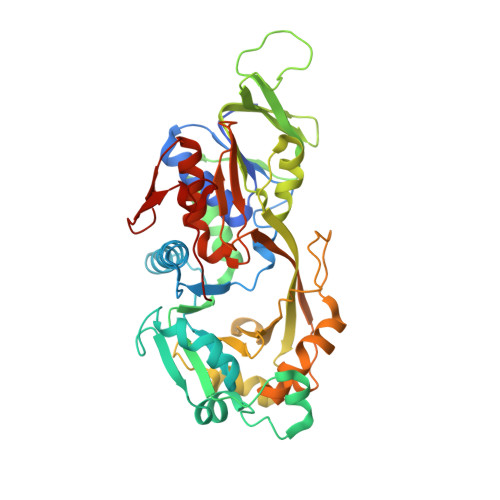Crystal Structure of Novel Dye-linked L-Proline Dehydrogenase from Hyperthermophilic Archaeon Aeropyrum pernix
Sakuraba, H., Satomura, T., Kawakami, R., Kim, K., Hara, Y., Yoneda, K., Ohshima, T.(2012) J Biol Chem 287: 20070-20080
- PubMed: 22511758
- DOI: https://doi.org/10.1074/jbc.M111.319038
- Primary Citation of Related Structures:
3AXB, 3VQR - PubMed Abstract:
Two types of dye-linked L-proline dehydrogenase (PDH1, α4β4-type hetero-octamer, and PDH2, αβγδ-type heterotetramer) have been identified so far in hyperthermophilic archaea. Here, we report the crystal structure of a third type of L-proline dehydrogenase, found in the aerobic hyperthermophilic archaeon Aeropyrum pernix, whose structure (homodimer) is much simpler than those of previously studied L-proline dehydrogenases. The structure was determined at a resolution of 1.92 Å. The asymmetric unit contained one subunit, and a crystallographic 2-fold axis generated the functional dimer. The overall fold of the subunit showed similarity to that of the PDH1 β-subunit, which is responsible for catalyzing L-proline dehydrogenation. However, the situation at the subunit-subunit interface of the A. pernix enzyme was totally different from that in PDH1. The presence of additional surface elements in the A. pernix enzyme contributes to a unique dimer association. Moreover, the C-terminal Leu(428), which is provided by a tail extending from the FAD-binding domain, shielded the active site, and an L-proline molecule was entrapped within the active site cavity. The K(m) value of a Leu(428) deletion mutant for L-proline was about 800 times larger than the K(m) value of the wild-type enzyme, although the k(cat) values did not differ much between the two enzymes. This suggests the C-terminal Leu(428) is not directly involved in catalysis, but it is essential for maintaining a high affinity for the substrate. This is the first description of an LPDH structure with L-proline bound, and it provides new insight into the substrate binding of LPDH.
Organizational Affiliation:
Department of Applied Biological Science, Faculty of Agriculture, Kagawa University, 2393 Ikenobe, Miki-cho, Kita-gun, Kagawa 761-0795, Japan.

















